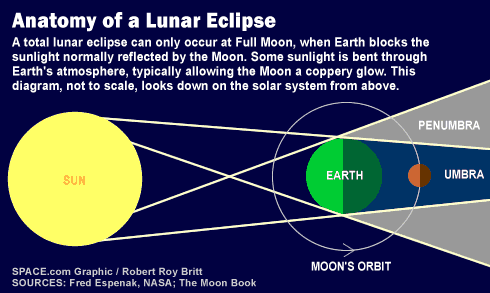What is an eclipse?
 When the Earth, moon and sun are all perfectly aligned, observers on Earth may be able to witness an eclipse. There are two main types of eclipses; lunar eclipses and solar eclipses.
When the Earth, moon and sun are all perfectly aligned, observers on Earth may be able to witness an eclipse. There are two main types of eclipses; lunar eclipses and solar eclipses.
A lunar eclipse occurs when the Earth lies between the sun and the Moon, and the Earth’s shadow falls on the Moon. Anyone on the side of the Earth that faces the Moon at that time can see such an eclipse. If only the outer part of Earth’s shadow croses the Moon, then a partial eclipse is seen; if the central part of the shadow covers the Moon, the result is a total eclipse.
A solar eclipse occurs when the Moon lies between the sun and the Earth, and blocks the view of the sun. If the Moon only partially blocks the sun then this causes a partial eclipse; if the Moon completely coves the sun, the result is a total eclipse.
So what is going to happen?
The last Lunar eclipse visible from the UK took place on December 10, 2011, but unfortunately most of the eclipse was over when the Moon rose at 15:55. When the Umbral phase ended at 16:18, the Moon was only be 2° 43′ above the horizon.
When is the next eclipse?
There will be some Penumbral eclipses, but as the Moon will not pass through the main part of the Earth’s shadow, there will not be much to see, and if you didn’t know that an eclipse was taking place you would not be aware of it.
So we will have to wait for a decent lunar eclipse until the early morning of September 28, 2015.
The next good lunar eclipses after that are on July 27, 2018 and January 21, 2019.
There is also a Transit of Mercury on May 9, 2016 which will be visible in the UK from start to finish. A further transit that takes place on November 11, 2019 though it will only be possible to see part of it from the UK.